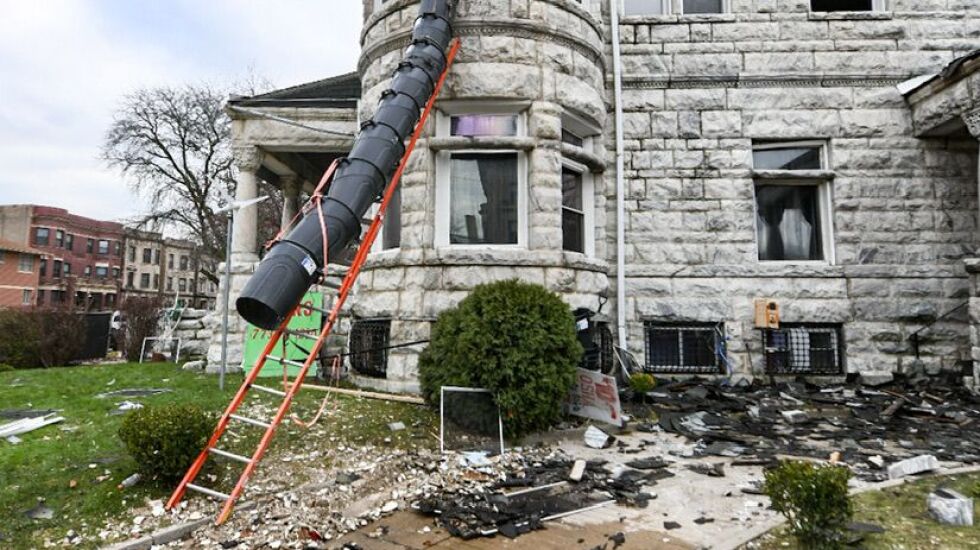
One by one, sheets of plywood were pulled from the back of the dark-colored van that sat Monday outside the Swift Mansion, a rambling 19th century stone manse at 45th Street and South Michigan Avenue.
This is a normal occurrence in Bronzeville, where owners both new and old frequently snap up the community’s landmark-quality homes and apartment buildings and hire workers to renovate them.
But the crew at 4500 S. Michigan Ave. was not there to fix up the 131-year-old Swift Mansion. Instead, they were there to board it up, a day after the historic structure was ravaged by a fire stubborn enough to rekindle itself twice before firefighters were able to finally fully knock out the blaze.
The fire is under investigation. But the building’s fate could rest with the results of a structural report now being prepared by inspectors with the city Department of Buildings.
The city could order the home demolished if it’s determined the fire rendered the building structurally unsound and unsafe.
The building was placed on the National Register of Historic Places in 1978. Its unfortunate loss — if it happens — would spell the end of one of the city’s remaining grand old Gilded Age mansions, a class that includes the Glessner House, 1800 S. Prairie Ave., from 1887, and the Nickerson Mansion, built in 1883 at 40 E. Erie St.
And it would also be a huge blow to the architectural heritage of Chicago and Bronzeville — a neighborhood rich with buildings that speak to the community’s early history as the city’s first Gold Coast, followed by its remarkable second life as a national birthplace of Black culture, history, music, commerce, literature and politics.
Built as a wedding present
Built in 1892, the three-story stone mansion was a wedding gift from meatpacker Gustavus Swift — who made a vast fortune at Chicago’s massive old Union Stockyards a few miles west of the home — to his daughter Helen and her new husband, Edward Morris.
South Michigan Avenue — as well as King Drive and South Drexel Boulevard — were lined with residences built by the city’s monied class. But there were few like this one.
The home’s Richardson Romanesque exterior boasts a three-story turret on its northeast corner and a carriage port on its 45th Street side that features six marble columns.
The interior — most of which was still intact until the fire — was a treasure of oak paneling, wood-beamed ceilings, fireplaces and a main stairway of intricately carved details.
“The gorgeous wood,” said Ald. Pat Dowell (3rd), a former urban planner and preservationist whose ward contains the house.
“The wood staircase, the bookshelves — these are things you can’t replace,” she said.

When the neighborhood became predominantly Black starting in the 1920s, the swank home was converted into an upscale funeral parlor catering to the community’s new population.
The building later became the Chicago Urban League’s longtime home until the civil rights group built its new modern headquarters in 1982 next door at 4510 S. Michigan Ave. The mansion was most recently home to the Inner City Youth and Adult Foundation.
An important icon in a historic neighborhood
Sunday’s fire tore extensively through the home’s roof, exposing the attic and upper floor to daylight.
The second- and third-story windows were broken out to fight the blaze, soaking the building’s detailed original oak-paneled interiors in water.
If wrecked, the mansion would suffer the same untimely end as Antioch Missionary Baptist Church, 6248 S. Stewart Ave. The city ordered the razing of the 140-year-old church after a 2022 fire left the stone building in ruins.

Workers on Monday also readied for the task of removing fire debris from the property. A large fire-engine red dumpster sat near the entrance to the carriage port.
“No matter where you go in Chicago, somebody has a connection to that building,” Dowell said.
“Any time you have an important icon in a historic community like Bronzeville — that you could potentially lose — it shakes up the memory banks a bit,” she said. “And pulls at the heart strings.”
Lee Bey is the Chicago Sun-Times architecture critic and a member of the Editorial Board. He is the author of “Southern Exposure: The Overlooked Architecture of Chicago’s South Side.”







